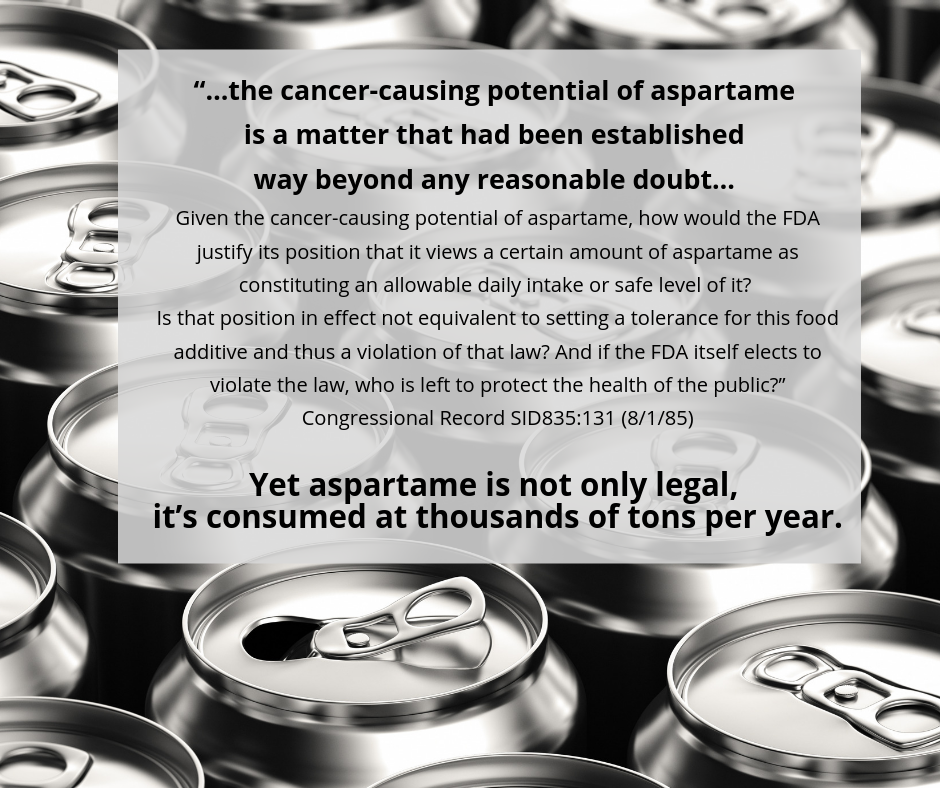Your Diet Soda contains known carcinogenic additives brought to you by Monsanto

Aspartame, commonly sold as Neotame®, Equal®, NutraSweet®, Blue Zero Calorie Sweetener Packets™, Advantame®, NutraSweet New Pink, Canderel®, Pal Sweet Diet® and AminoSweet® is typically found in “diet” foods like diet soda as well as gum, yogurt, processed honey, and fruit juice (1). In a 22-year landmark study published in The American Journal of Clinical Nutrition involving over 125,000 people, significant links were found between daily intake of aspartame and the development of leukemia and lymphoma. (1)This research begs the question: what will we find about the effects of aspartame on human health twenty years from now, when the generation that grew up with it is at middle age?
Aspartame wasn’t always a food product, it actually originated as an experimental ulcer medication.
Once it came onto the market, it didn’t last very long: 1980 the FDA banned the substance after having 3 independent scientist studied the artificial sweetener. The substance was linked “without a shadow of a doubt” to brain tumors and brain cancer by the FDA’s own toxicologist, Dr. Adrian Gross (10).
It was even found to mimic and worsen fibromyalgia, MS, lupus, ADD, diabetes, Alzheimer’s, and chronic fatigue.
Aspartame Dangers You’ve Never Heard Of
Aspartame is broken down into “phenylalanine (50%), aspartic acid (40%) and methanol (10%) during metabolism in the body. The excess of phenylalanine blocks the transport of important amino acids to the brain contributing to reduced levels of dopamine and serotonin.” (4)
Aspartic acid acts as a neurotoxin that causes the hyperexcitability of neurons. It’s also a precursor to another amino acid that overexcites your central nervous system (CNS): glutamates.
Methanol and its metabolites cause CNS depression, vision disorders and other symptoms. Chronic exposure can lead to metabolic acidosis and, eventually, coma. Alcohol dehydrogenase (ADH), which are present in your brain, also converts methanol to formaldehyde (5).
Another metabolite, diketopiperazine, is carcinogenic in the central nervous system and contributes towards the formations of tumors, including gliomas, medulloblastomas, and meningiomas.
Plus, the substance “has been linked to pediatric and adolescent migraines. Upon ingestion, aspartame is broken, converted, and oxidized into formaldehyde in various tissues.”(5). Not only is formaldehydecarcinogenic, it’s also cumulative, meaning that it builds up in your body (6,7).
Lastly, since serotonin and dopamine are key “happy” hormones, aspartame can directly contribute towards mental disorders, addiction, and including depression, suicidal behavior, and substance abuse (8).
In an open letter to the FDA, the Aspartame Toxicity Information Center warns “Some of the many aspartame toxicity symptoms reported include seizures, headaches, memory loss, tremors, convulsions, vision loss, nausea, dizziness, confusion, depression, irritability, anxiety attacks, personality changes, heart palpitations, chest pains, skin diseases, loss of blood sugar control, arthritic symptoms, weight gain (in some cases), fluid retention, excessive thirst or urination. Clearly, regular exposure to a toxic substance such as formaldehyde may worsen, or in some cases contribute to the development of chronic diseases.”(9)
Mega Study Reveals Cancer Connection
“A recent mega experiment in 1800 rats tested at aspartame doses much lower than the currently acceptable daily intake (ADI) for humans reported a dose-dependent increase in lymphomas, leukemias, and transitional renal cell tumors.” (2, 3)
Broken down, here are the primary results of this mega-study.
- Consuming only one 12-ounce can of diet soda per day increased risk of lymphoma and myeloma (cancer of blood plasma), the incidence increasing in correlation with aspartame intake. The risk was much higher in men (it hasn’t been identified why that is the case).
- There is an elevated risk of lymphoma with higher consumption of non-diet soda in men than women.
- Annual consumption of aspartame in the United States is estimated at 5000-5500 tons and the most common product in which it is used is diet soda.
- Aspartame (especially in liquids) breaks down into asparitic acid, methanol, and phenylalanine; when ingested, methanol turns into formaldehyde—a known carcinogen.
- Previous studies that didn’t support a link between aspartame and cancer were limited in time and scope. This study included a large sample size and scientifically-viable time period and tested subjects at intervals throughout the study.
- Subjects’ measured aspartame intake included that added from packets (e.g., NutraSweet and Equal) and contributed to the weighting of the results.
- Subjects with a higher intake of diet soda had a higher body mass index and animal protein intake and were less likely to smoke. (This is highly significant: it is known that aspartame contributes to obesity and metabolic syndrome; the result noted here corroborates that finding. Additionally, this group of diet soda drinkers didn’t smoke cigarettes, discounting smoking as a contributing factor to the development of cancer in the study.)
Other studies show a direct connection between the methanol in aspartame and neurological disease.

If this isn’t enough to get you to kick the can to the curb for good (and then recycle it!),
Read more at:
https://deeprootsathome.com/aspartame-the-most-dangerous-food-additive-on-the-market-3/






